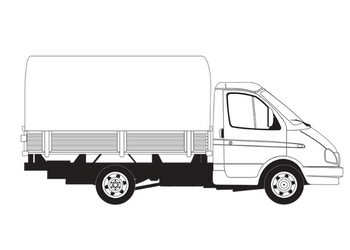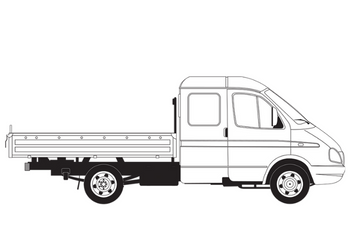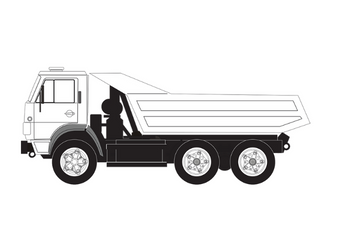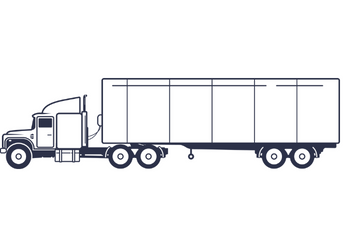
Truck Classification | Light vs. Medium vs. Heavy Duty
Truck Classes 1-8
In short, truck classification looks at the Gross Vehicle Weight Rating (GVWR). It is how the manufacturers label trucks based on government guidelines. The GVWR entails the maximum truck weight plus what it can carry when fully loaded. This GVWR includes the truck’s weight plus fuel, cargo, passengers, and the trailer tongue. The trailer classification regulates safety, but it’s also useful for commercial designation and when registering vehicles.
For example, when comparing light-duty vs. heavy-duty trucks, you’ll notice that heavy-duty, Class 8 trucks, have the heaviest GVWR, while the light-duty, class 1 trucks, will have the lightest.
Why is Truck Classification Important?
In a nutshell, a truck’s GCWR is used for other important metrics such as how long a truck can operate continuously, what kind of permits you need to operate it, and whether you need to stop at weigh stations.
Some of the aspects impacted by the GVWR are:
Permit requirements
If you’re hauling oversized equipment, you might be required to provide certain identifying marks and permits to proceed.
DOT Number Regulations
If your truck is more than 10,001 pounds, it must have a Department of Transportation (DOT) number on both sides of your vehicle, not just one.
Maintenance Needs
Repair shops or mobile mechanics aren’t going to be able to properly prepare for you if they don’t have the correct information regarding your vehicle. If you say, “class 8”, they’ll know exactly what they’ll need and the right tools and enough space to fit you in.
License Levels
It is not a one-license-fits-all for the big trucks. A driver will need a CDL to operate any truck over 26,000 pounds. It doesn’t stop there- the CDL license is then divided into Class A (26,001 pounds, given you’re towing something over 10,000 pounds); Class B (26,001 pounds or more, towing a vehicle that weighs up to 10,000 pounds); or Class C (passenger transport or hazardous materials).
Hours of Service (HOS) Laws
If you’re driving a vehicle that weighs more than 10,001 pounds, FMCSA’s Interstate Truck Driver’s Hours of Service will apply to you.
Weigh Station Guidelines
If you exceed a certain amount of weight, you are required to stop at weigh stations.
Vehicle Categories & Their Classifications
Categories begin with Class 1 and go through Class 9. Considered the “light” classes 1-3 typically include non-commercial vehicles- minivans, cargo vans, SUVs, and pickup trucks for example.
Light-Duty Truck Classification
Class 1: This class of truck has a GVWR of 0-6,000 pounds.
Class 2: GVWR of 6,001 – 10,000 pounds
Class 3: GVWR of 10,001- 14,000 ex: RAM 3500, Chevy Silverado 3500, Ford F-350
Medium-Duty Truck Classification
This category includes commercial truck classes 4-6. This is where commercial trucks start to show up. Class 4 & 5 include some full-size trucks used non-commercially. Still, most medium-class vehicles are made for commercial purposes.
Class 4: GVWR of 14,001 – 16,000 pounds. This class is where you’ll find the Ford E-450 passenger van and the F-450 super-duty pickup. Box trucks will typically fall into this category. So do some large walk-in and city delivery trucks.
Class 5: GVWR of 16,001 – 19,500 pounds. In this category, there are still a couple of stragglers that straddle the line between non-commercial and commercial vehicles such as the Ford F-550. This also includes larger walk-ins and delivery trucks, as well as bucket trucks or cherry pickers.
Class 6: GVWR of 19,501 – 26,000. This class covers medium-duty commercial trucks. Vehicles in this class include single axles, beverage trucks, rack trucks, and school buses. This class also introduces the requirement of the Commercial Driver’s License. This requirement depends on the individual vehicle’s weight.


Heavy-Duty Truck Classification
The heavy-duty truck classification includes classes 7 & 8. This is where you’ll find the big rigs and other commercial vehicles.
Class 7: GVWR of 26,001 – 33,000 pounds and typically has 3 or more axles. This class includes city vehicles such as street sweepers, garbage trucks, and city transit buses. Furniture trucks and smaller semis fit into this category.
Class 8: GVWR over 33,002 pounds. These are huge trucks. This class is more than heavy-duty but rather “super duty”. Class 8 applies to cement trucks and dump trucks. It’s also the big rigs like Freightliners, Kenworths, and Peterbilts.


Let Speed Wrench Take Care of Your Light & Heavy Duty Repairs Today!
We hope you have a better understanding of the different truck classifications and what makes each one unique and why it fits in its particular category. If you are ever looking for truck repairs for either light, medium, or heavy-duty trucks- look no further! Speed Wrench has a team of skilled truck mechanics & technicians that are ready to help with any problem you have!
